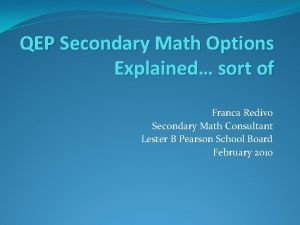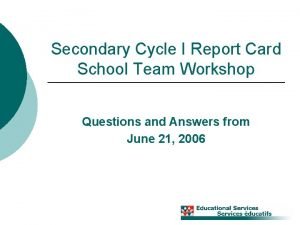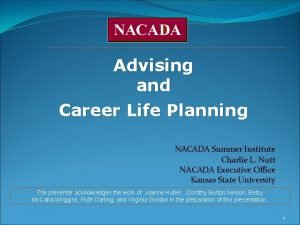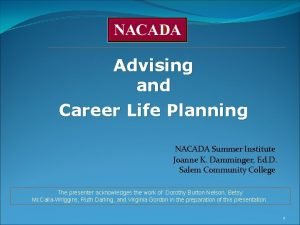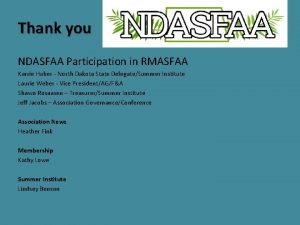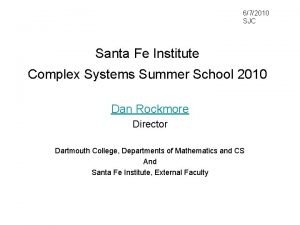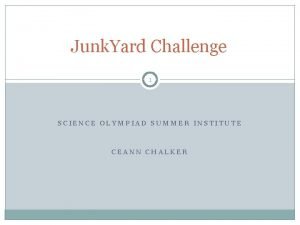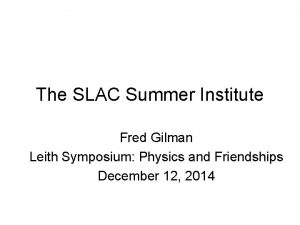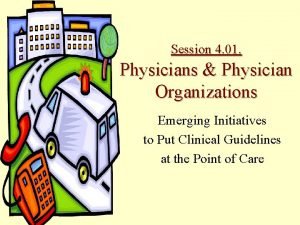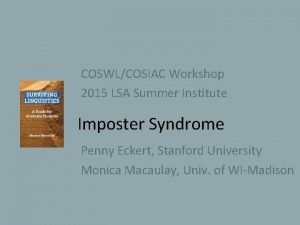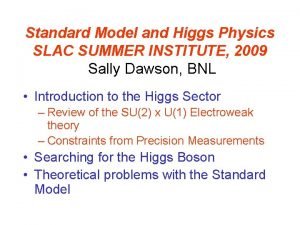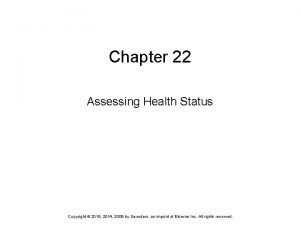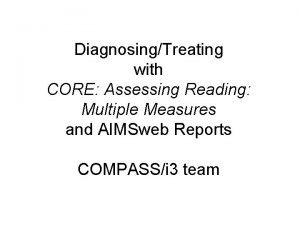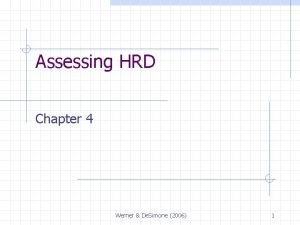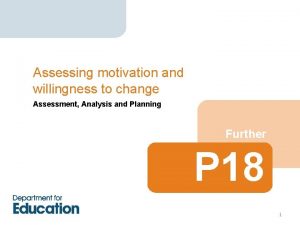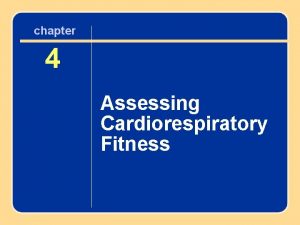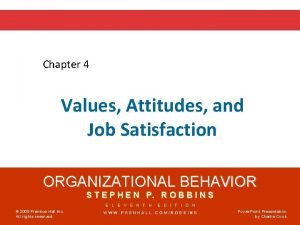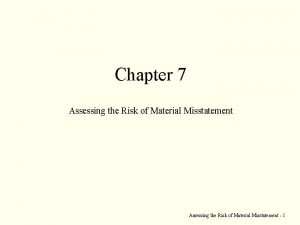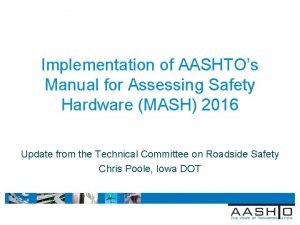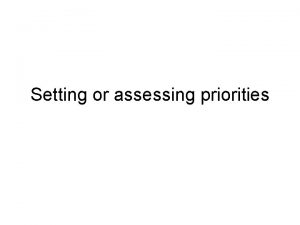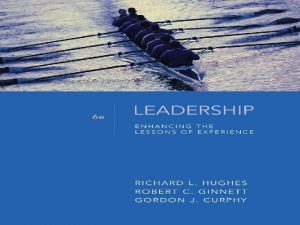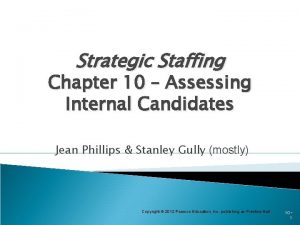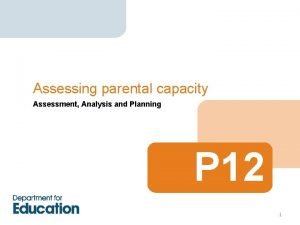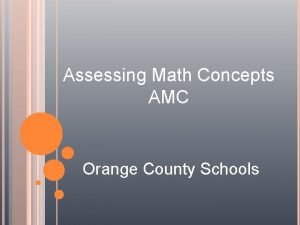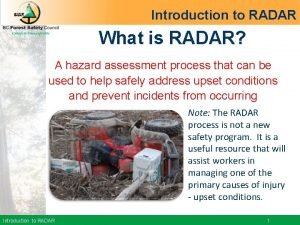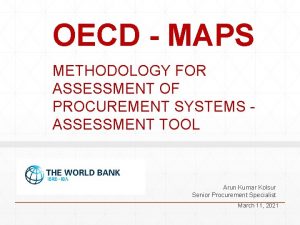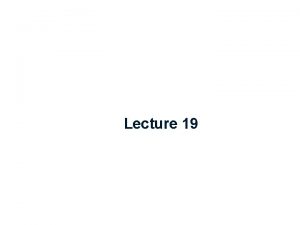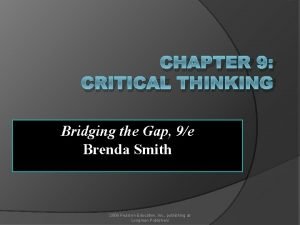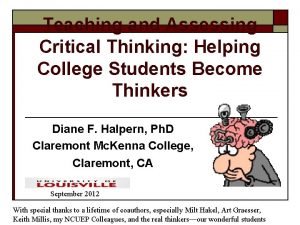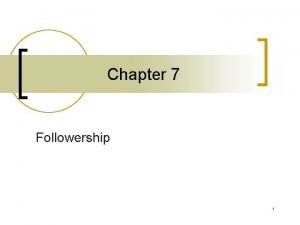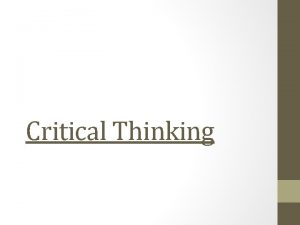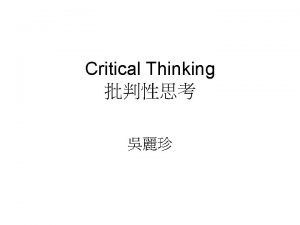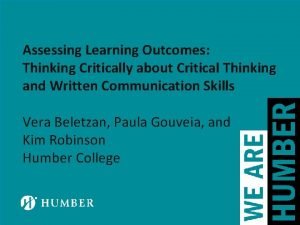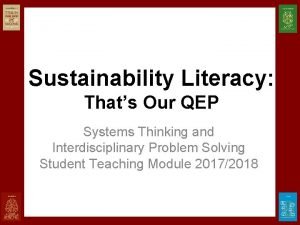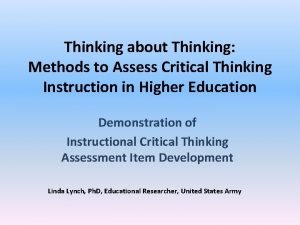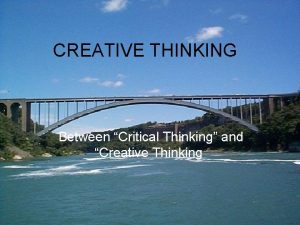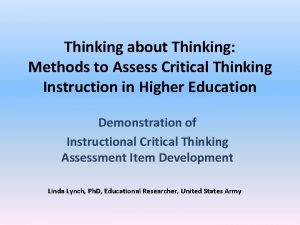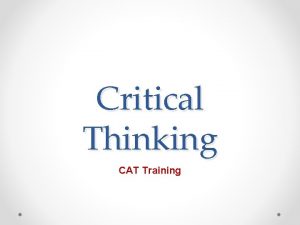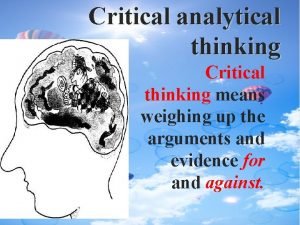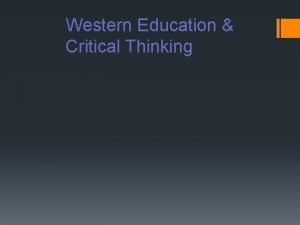Assessing Critical Thinking Summer Critical Thinking Institute QEP





















































- Slides: 53

Assessing Critical Thinking Summer Critical Thinking Institute QEP Team, Faculty Champions, and Academic Roundtables June 20, 2008 Critical Thinking Institue 2008

Critical Thinking Assessing Critical Thinking 2008 “Beyond the Obvious” June 20, 2008 Critical Thinking Institue 2

Assessment Basics Assessing Critical Thinking 2008 Purpose of assessment q Creating valid and reliable measures q Alignment of goals/measures q Use of multiple methods q June 20, 2008 Critical Thinking Institue 3

Assessment Basics Assessing Critical Thinking 2008 Why do we assess? q q q To see how well we are doing To confirm what we already know To share our progress with others To see where we can improve and change In some cases to demonstrate what does not work June 20, 2008 Critical Thinking Institue 4

Assessment Basics Assessing Critical Thinking 2008 Why do we assess? Source: http: //www. c-pal. net/course/module 2/pdf/Week 1_Lesson 5. pdf June 20, 2008 Critical Thinking Institue 5

Assessment Basics Assessing Critical Thinking 2008 Does one size fit all? q Assessments need to be valid q Assessments need to be reliable June 20, 2008 Critical Thinking Institue 6

Validity Assessing Critical Thinking 2008 Does the assessment measure what it is suppose to measure? q “Validation is the process of accumulating evidence that supports the appropriateness of inferences that are made of student responses…” (AERA, APA, & NCME, 1999) June 20, 2008 Critical Thinking Institue 7

Types of Validity Evidence Assessing Critical Thinking q q 2008 Content Related - the extent to which a student’s responses to a given assessment reflect that student’s knowledge of the content area Construct Related - the extent to which the responses being evaluated are appropriate indicators of the underlying construct Criterion Related - the extent to which the results of the assessment correlate with a current or future event Consequential – the consequences or use of the assessment results June 20, 2008 Critical Thinking Institue 8

Questions to Examine Validity Assessing Critical Thinking 2008 Content Validity Evidence 1. Does the evaluation criteria address any extraneous content? 2. Does the evaluation criteria address all of the aspects of the intended content? 3. Is there any content addressed in the task that should be evaluated, but is not? June 20, 2008 Critical Thinking Institue 9

Questions to Examine Validity Assessing Critical Thinking 2008 Construct Validity Evidence 1. Are all the important elements of the material evaluated through the scoring criteria? 2. Are any of the evaluation criteria NOT relevant to the material? June 20, 2008 Critical Thinking Institue 10

Questions to Examine Validity Assessing Critical Thinking 2008 Criterion Validity Evidence 1. What are the important components of the future performance that may be evaluated through the use of this assessment? 2. How does the scoring criteria measure the important components of the future performance? 3. Are there any elements of the future performance that are not reflected in the scoring criteria? June 20, 2008 Critical Thinking Institue 11

Reliability Assessing Critical Thinking 2008 Consistency of the assessment scores q Types of reliability… ü ü q Interrater Reliability – scores vary from instructor to instructor. Intrarater Reliability – scores vary from a single instructor from paper to paper A test can be reliable and not valid, but never valid and not reliable June 20, 2008 Critical Thinking Institue 12

Reliability Concerns Assessing Critical Thinking 2008 Reliability 1. Are the score categories well defined? 2. Are the differences between the score categories clear? 3. Would two independent raters arrive at the same score for a given student response based on the scoring rubric? June 20, 2008 Critical Thinking Institue 13

Improving Scoring Consistency Assessing Critical Thinking q q q 2008 Provide grading rubrics or scoring criteria to students prior to assessment Grade papers anonymously Use anchor papers to define levels of proficiency for reference Use multiple scorers Calculate reliability statistics during training and grading June 20, 2008 Critical Thinking Institue 14

Assessment Basics Assessing Critical Thinking 2008 Assessment Purpose q Everything needs to align (objectives through assessment) q SPC QEP example June 20, 2008 Critical Thinking Institue 15

Assessment Basics Assessing Critical Thinking Definition Appropriate Assessment Measures June 20, 2008 Operational Elements (KSAs) Measurable Learning Outcomes Critical Thinking Institue 16

SPC Definition Assessing Critical Thinking Definition Operational Elements (KSAs) Appropriate Assessment Measures Measurable Learning Outcomes June 20, 2008 “Critical thinking is the active and systematic process of communication, problemsolving, evaluation, analysis, synthesis, and reflection, both individually and in community, to foster understanding, support sound decisionmaking, and guide action. ” Critical Thinking Institue 17

Student Learning Outcomes Assessing Critical Thinking 2008 In order to link specific and measurable student learning outcomes, SPC’s definition of critical thinking was operationalized. q This provided a more concrete and less abstract linkage or bridge between the student learning outcomes and the definition of critical thinking. q June 20, 2008 Critical Thinking Institue 18

Student Learning Outcomes Assessing Critical Thinking Definition Operational Elements (KSAs) Appropriate Assessment Measures Measurable Learning Outcomes June 20, 2008 Critical Thinking Institue 19

Student Learning Outcomes Assessing Critical Thinking Definition Operational Elements (KSAs) Appropriate Assessment Measures Measurable Learning Outcomes June 20, 2008 Critical Thinking Institue 20

Outcomes to Assessments Assessing Critical Thinking 2008 Student Learning Outcomes were then linked to appropriate assessment instruments q SPC’s QEP contained multiple measures for use in assessing student learning in the area of critical thinking q June 20, 2008 Critical Thinking Institue 21

Outcomes to Assessments Assessing Critical Thinking Definition Operational Elements (KSAs) Appropriate Assessment Measures Measurable Learning Outcomes June 20, 2008 Critical Thinking Institue 22

Recent Alumni Survey Assessing Critical Thinking q 2008 Question 31: Thinking logically and critically to solve problems Gathering and assessing relevant information q Inquiring about and interpreting information q Organizing and evaluating information q Analyzing and explaining information to others q Using Information to solve problems q June 20, 2008 Critical Thinking Institue 23

Employer Survey Assessing Critical Thinking q Question 3: Use mathematical and computational skills q q 2008 Comfortable with mathematical calculations Uses computational skills appropriately Accurately interprets mathematical data Question 5: Think logically and critically to solve problems q q q Gathers and assesses relevant information Inquires and interprets information Organizes and evaluates information Analyzes and explains information to others Uses Information to solve problems June 20, 2008 Critical Thinking Institue 24

CCSSE Assessing Critical Thinking q Question 5: During the current school year, how much has your coursework at this college emphasized the following mental activities? q q q 2008 b. Analyzing the basic elements of an idea, experience, or theory d. Making judgments about the value or soundness of information, arguments, or methods Question 12: How much has YOUR EXPERIENCE AT THIS COLLEGE contributed to your knowledge, skills, and personal development in the following areas? q e. Thinking critically and analytically June 20, 2008 Critical Thinking Institue 25

Assessment Basics Assessing Critical Thinking 2008 Multiple Measures q SPC will determine improvement in students’ critical thinking skills using the multiple measures. q These include standardized direct instruments, authentic assessments, and indirect methods. June 20, 2008 Critical Thinking Institue 26

Student Assessment Points Assessing Critical Thinking June 20, 2008 Critical Thinking Institue 27

Standardized Direct Instruments Assessing Critical Thinking 2008 Direct assessments include: q q q CAT - Critical Thinking Assessment Test is designed to assess and promote the improvement of critical thinking and real -world problem solving skills. Measure of Academic Proficiency and Progress (MAPP), developed by Educational Testing Services (ETS), is a measure of college-level reading, mathematics, writing, and critical thinking in the context of the humanities, social sciences, and natural sciences The i. Skills™ assessment (former ICT Literacy Assessment), developed by ETS, is a comprehensive test of Information and Communication Technology proficiency that uses scenario-based critical thinking tasks to measure both cognitive and technical skills. June 20, 2008 Critical Thinking Institue 28

Indirect Methods Assessing Critical Thinking 2008 Student, alumni, employer, faculty, and staff reports, such as end-of-course, institutional, and national surveys and questionnaires, can provide indirect measures that help deepen the interpretation of student learning (Maki, 2004). June 20, 2008 Critical Thinking Institue 29

Indirect Methods Assessing Critical Thinking 2008 Indirect methods include: q q q Community College Survey of Student Engagement (CCSSE), established at UT at Austin, a tool for assessing quality in community college education. CCSSE contains specific survey items intended to assess various Core Operational Elements (KSAs) associated with a student’s critical thinking. Entering Student Survey, Enrolled Student Survey, Graduating Student Survey, and Recent Alumni Survey are the primary surveys that have been developed to collect student feedback on their experiences. Employer Surveys are sent out to employers of recent SPC graduates in order to gather information on graduates’ knowledge and behavior. June 20, 2008 Critical Thinking Institue 30

Authentic Assessments Assessing Critical Thinking 2008 Authentic assessments serve dual purposes of encouraging students to think critically and of providing assessment data for measuring improved student learning. June 20, 2008 Critical Thinking Institue 31

Authentic Assessments Assessing Critical Thinking 2008 Authentic assessments include… q q q Criterion-referenced rubrics. Complex, higher-order objectives can be measured only by having students create a unique product, whether written or oral [in-class essays, speeches, term papers, videos, computer programs, blueprints, or artwork] (Carey, 2000). Student Reflection. Written reflection is espoused to have several important benefits: it can deepen the quality of critical thinking, increase active involvement in learning, and increase personal ownership of the new learning by the student (Moon, 1999). Student Portfolios. Collections of students’ work over a course or a program and can be an effective method of demonstrating student progress in the area of critical thinking (Carey, 2000). June 20, 2008 Critical Thinking Institue 32

Rubrics Assessing Critical Thinking 2008 What is a rubric? q Scoring guidelines, consisting of specific pre-established performance criteria, used in evaluating student work on performance assessments June 20, 2008 Critical Thinking Institue 33

Rubrics Assessing Critical Thinking 2008 SPC currently uses rubrics in such programs as… q College of Education q College of Nursing q Paralegal June 20, 2008 Critical Thinking Institue 34

Assessing Critical Thinking 2008 Assessment Rubric for Critical Thinking (ARC) June 20, 2008 Critical Thinking Institue 35

Assessment Rubric for CT Assessing Critical Thinking 2008 ARC was designed to… q Enhance the QEP q Align with the College’s definition of critical thinking q Be flexible for use in multi-disciplines June 20, 2008 Critical Thinking Institue 36

Assessment Rubric for CT Assessing Critical Thinking q q q 2008 ARC is a ‘global’ rubric template developed to provide a snapshot view of how student learning is being affected by the critical thinking initiative. ARC will be designed to assess a variety of student projects from a critical thinking perspective. For example, students in a composition class may be asked to write a paper on a specific topic. ARC rubric template will evaluate the student’s use of critical thinking skills in the development of the paper as opposed to specifically evaluating the quality of student’s writing skills. June 20, 2008 Critical Thinking Institue 37

Assessment Rubric for CT Assessing Critical Thinking q q 2008 ARC rubric template will be designed to be flexible enough to address a number of student project modalities including written and oral communications. The development of a rubric is an iterative process and will be improved and strengthened as it is used more widely; however, the first iteration of the rubric has been developed by the QEP faculty champions. June 20, 2008 Critical Thinking Institue 38

Rubric Development Process Assessing Critical Thinking 1. 2. 3. 4. 5. 6. 7. 2008 Re-examine the learning objectives to be addressed by the task Identify specific observable attributes your students should demonstrate Describe characteristics at each attribute Write narrative descriptions for each level of continuum Collect samples of student work Repeat as Score student work and identify samples that Needed exemplify various levels Revise the rubric as needed June 20, 2008 Critical Thinking Institue 39

Assessment Rubric for Critical Thinking Assessing Critical Thinking June 20, 2008 Critical Thinking Institue 40

Assessment Rubric for Critical Thinking Assessing Critical Thinking June 20, 2008 Critical Thinking Institue 41

Assessment Rubric for Critical Thinking Assessing Critical Thinking June 20, 2008 Critical Thinking Institue 42

ARC Assignment Profile Assessing Critical Thinking q q q 2008 Designed to provide consistency and accuracy in the evaluation of the ARC at the institutional level as well as provide guidelines for the use at the course level ARC is essentially a ‘tool’ to evaluate critical thinking, but for a tool to be effective it must be in the correct situation or ‘job. ’ It would be inefficient to use a machete to conduct heart surgery. Purpose of the ARC Assignment Profile is to outline the most appropriate course assignment June 20, 2008 Critical Thinking Institue 43

ARC Assignment Profile Assessing Critical Thinking q q 2008 Participating faculty should have one assignment during the course that can be evaluated using the ARC scoring rubric. Course assignment could be a graded homework assignment or a major assessment for the course. Course assignment should include all of the elements of the rubric and should be aligned with the task outlined for each element. Assignments that only evaluate some of the elements or are not aligned with the specific ARC tasks will be considered incomplete and not used in the institutional analysis. June 20, 2008 Critical Thinking Institue 44

ARC Assignment Profile Assessing Critical Thinking q 2008 Faculty may additional discipline specific rubric elements (such as grammar and punctuation in a composition class), but must maintain the ARC elements as listed. June 20, 2008 Critical Thinking Institue 45

ARC Assignment Profile Assessing Critical Thinking 2008 Students should be provided a copy of the assignment rubric (ARC and any additional discipline specific elements). The specific elements and tasks include: 1. 2. 3. 4. 5. 6. Communication: Define the problem in your own words. Analysis: Compare & contrast the available solutions within the scenario. Problem Solving: Select one of the available solutions and defend it as your final solution. Evaluation: Identify the weaknesses of your final solution. Synthesis: Suggest ways to improve/strengthen your final solution (may use information not contained within the scenario). Reflection: Reflect on your own thought process after completing the assignment. a. “What did you learn from this process? ” b. “What would you do differently next time to improve? ” June 20, 2008 Critical Thinking Institue 46

ARC Assignment Profile Assessing Critical Thinking q q q 2008 Evaluating scenario (selected or created) should be stated in such a manner to allow the student to address each of the tasks. QEP team is willing to assist you with the creation of the scenario or identify possible sources of existing scenario that could be used. Completed student assignments should include a copy of the scenario, the assignment provided to the student (with the rubric), the students work and the final graded rubric. June 20, 2008 Critical Thinking Institue 47

Deer Population Scenario Three teenagers were seriously injured in a car accident when Assessing Critical Thinking swerving to avoid a deer in on a two-lane road near a small, 2008 rural town in Florida. The residents of the town have seen more and more deer enter the town’s populated areas over recent years. Local law enforcement has been called numerous times this year to remove the animals from backyards and neighborhood streets, and one deer even caused considerable damage as it entered a restaurant in town. The mayor has been charged by the city leaders to keep the town residents safe. Local crops have even been damaged by the animals. Some long time residents have requested that the hunting season and catch limits be extended in order to reduce the deer population. One city leader even proposed that the city purchase electronic devices to deter the deer from entering populated areas. Health concerns have recently been elevated as three deer carcasses were found at the edge of town and local law enforcement suspect that the animals had been poisoned. June 20, 2008 Critical Thinking Institue 48

Next Steps Assessing Critical Thinking q q 2008 Another Scoring workshop will be held this Fall Pairs of Faculty Champions (scorers) will individually score student work samples and identify samples that exemplify various levels June 20, 2008 Critical Thinking Institue 49

Next Steps Assessing Critical Thinking 2008 Faculty Champions (scorers) will complete evaluation forms regarding the validity and reliability of the ARC rubric q Interrater reliability will also be calculated from ARC ratings q June 20, 2008 Critical Thinking Institue 50

Next Steps Assessing Critical Thinking 2008 Faculty champions will make revisions to the ARC and the assignment profile as needed. q ARC Development Process will be repeated (Steps 5 - 7) q June 20, 2008 Critical Thinking Institue 51

Questions/Next Steps Assessing Critical Thinking June 20, 2008 Critical Thinking Institue 52

Assessing Critical Thinking Summer Critical Thinking Institute QEP Team, Faculty Champions, and Academic Roundtables June 20, 2008 Critical Thinking Institue 2008
 Qep secondary
Qep secondary Fsot qep
Fsot qep Swlsb gpi
Swlsb gpi Qep broad areas of learning
Qep broad areas of learning Spaulding classification
Spaulding classification Critical semi critical and non critical instruments
Critical semi critical and non critical instruments Perbedaan critical thinking dan creative thinking
Perbedaan critical thinking dan creative thinking Nacada summer institute
Nacada summer institute Nacada summer institute
Nacada summer institute Scioly protein modeling
Scioly protein modeling Ndasfaa
Ndasfaa Santa fe institute summer school
Santa fe institute summer school Apbythesea
Apbythesea Science olympiad summer institute
Science olympiad summer institute Slac summer school
Slac summer school Nchfma summer institute
Nchfma summer institute So cal science olympiad
So cal science olympiad Lsa summer institute
Lsa summer institute Slac summer institute
Slac summer institute Group discussion
Group discussion Assessing the internal environment of the firm
Assessing the internal environment of the firm Assessing health status chapter 22
Assessing health status chapter 22 Assessing a new venture's financial strength and viability
Assessing a new venture's financial strength and viability Many new drivers first fender bender is a backing collision
Many new drivers first fender bender is a backing collision Unit 18 assessing children's development support needs
Unit 18 assessing children's development support needs Cultural dynamics in assessing global markets
Cultural dynamics in assessing global markets Core multiple measures
Core multiple measures Strengths and weaknesses in reading
Strengths and weaknesses in reading Assessing hrd needs
Assessing hrd needs Assessing motivation to change
Assessing motivation to change Assessing cardiorespiratory fitness
Assessing cardiorespiratory fitness Module 4 topic 1 assessing and managing risk
Module 4 topic 1 assessing and managing risk Ways to address grammar in the writing classroom ppt
Ways to address grammar in the writing classroom ppt Assessing value for money
Assessing value for money Dominant work values in today's workforce
Dominant work values in today's workforce Risk of material misstatement table
Risk of material misstatement table Aashto manual for assessing safety hardware
Aashto manual for assessing safety hardware Assessing opportunity cost involves
Assessing opportunity cost involves Assessing leadership and measuring its effects
Assessing leadership and measuring its effects A nine box matrix requires assessing employees on ________.
A nine box matrix requires assessing employees on ________. Domain 5 ppst
Domain 5 ppst Parental capacity example
Parental capacity example Cultural dynamics in assessing global markets
Cultural dynamics in assessing global markets Assessing math concepts
Assessing math concepts Chapter 4 cultural dynamics in assessing global markets
Chapter 4 cultural dynamics in assessing global markets Btec sport level 3 unit 3
Btec sport level 3 unit 3 Assessing the situation
Assessing the situation Oecd maps
Oecd maps Assessing need for hrd
Assessing need for hrd Compare non-critical readers with critical readers.
Compare non-critical readers with critical readers. Chapter 9 critical thinking answers
Chapter 9 critical thinking answers Thinking skills
Thinking skills Eku compass
Eku compass Independent critical thinking
Independent critical thinking
